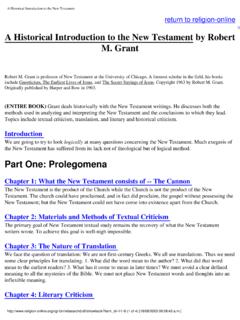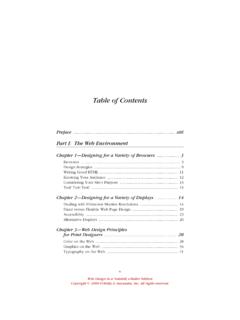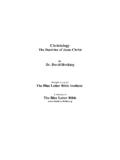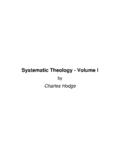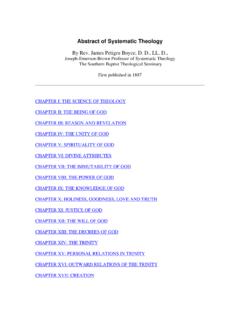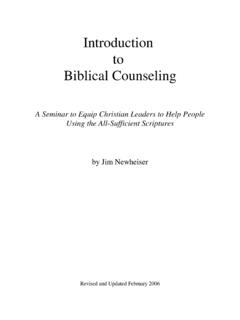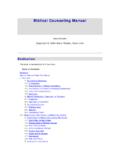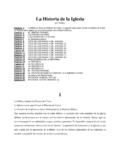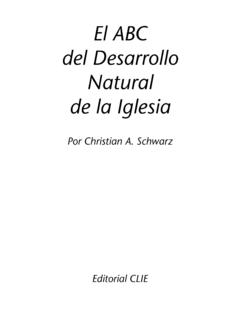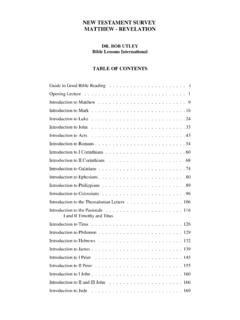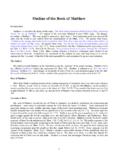Transcription of Introduction to the New Testament - The NTSLibrary
1 Introduction to the New TestamentbyLouis BerkhofAbout Introduction to the New Testament by Louis BerkhofIntroduction to the New TestamentTitle: :Berkhof, LouisAuthor(s):Grand Rapids, MI: Christian Classics Ethereal LibraryPublisher:Public DomainRights:2004-04-02 Date Created:Mike Randall (Digitizer)Contributor(s):All; BibleCCEL Subjects:Table of Contentsp. iiAbout This Book..p. 1 Title Page..p. 2 Preface..p. 3 Prolegomena..p. 12 The Gospels in General..p. 30 Matthew..p. 38 Mark..p. 46 Luke..p. 53 John..p. 61 Acts..p. 68 The Epistles in General..p. 74 The Epistles of Paul..p. 77 The Epistle to the Romans..p. 84 The First Epistle to the Corinthians..p. 90 The Second Epistle to the Corinthians..p. 95 The Epistle to the Galatians..p. 102 The Epistle to the Ephesians..p. 108 The Epistle to the Philippians.
2 P. 113 The Epistle to the Colossians..p. 118 The First Epistle to the Thessalonians..p. 123 The Second Epistle to the Thessalonians..p. 127 The Pastoral Epistles..p. 132 The First Epistle to Timothy..p. 136 The Second Epistle to Timothy..p. 139 The Epistle to Titus..p. 142 The Epistle to Philemon..p. 145 The Epistle to the Hebrews..p. 153 The General Epistle of James..p. 160 The First General Epistle of Peter..p. 167 The Second General Epistle of Peter..p. 173 The First General Epistle of John..p. 178 The Second and Third General Epistles of John..p. 182 The General Epistle of Jude..p. 186 The Revelation of John..p. 194 Indexes..iiiLouis BerkhofIntroduction to the New Testamentp. 194 Index of Scripture References..p. 196 Index of Scripture Commentary..ivLouis BerkhofIntroduction to the New TestamentNew Testament IntroductionLouis BerkhofEerdmans, 1915 Scanned and proofread by Mike RandallLouis BerkhofIntroduction to the New TestamentPREFACEThis little work on New Testament Introduction is the result of labor done in and for theclass-room, and is primarily intended for my own students.
3 It is not and does not pretend to be awork of original research, but depends in a large measure on the labors of such men as Davidson,Reuss, Weiss, Westcott, Lightfoot, Godet, Holtzmann, Julicher, Zahn, e. a. The indebtedness tothese will be evident from its method of treatment I have partly gone my own way, both in virtue of principles that are notgenerally recognized in works of Introduction and for practical considerations. As far as the limitsof the work allowed, the directions given by Dr. Kuyper in his Encyclopaedia of Sacred Theologyhave been followed; not only the human but also the divine side of the Sacred Scriptures has has been my constant endeavor in writing this book, to make it a work that would introducethe students to the books of the New Testament , as they have in fact been transmitted to the Church,and not as some critic or other would have them be.
4 Hence critical questions, though not disregarded,do not loom as large on its pages as they often do in works on Introduction ; the positive constructiveelement has a decided precedence over the apologetic; and the human factor that operated in theorigin and composition of the Scriptures, is not studied to the neglect of the limited number of copies was printed, partly in deference to the expressed wish of some ofmy present and past students, and partly because I desire to use it as a text-book in the future, therebeing none of the smaller works on Introduction , such as those of Dods, Pullan, Kerr, Barth, Peakee. a., however excellent some of them may be in their own way, that gave me what I desired. If thebook may in some small measure be instrumental in leading others to a greater appreciation andan ever better understanding of the New Testament writings, I shall be very grateful Rapids, Mich.
5 , November 30, BerkhofIntroduction to the New NAME AND name Introduction or Isagogics (from the Greek ) did not always denote what itdoes today. As it is used by the monk Adrianus (circa 440) and by Cassiodorus (circa 570), itdesignates a conglomeration of rhetorical archaeo1ogica1, geographical and historical matter suchas might be helpful in the interpretation of Scripture. In course of time the connotation of the wordchanged. Michaelis (1750) was the first one to employ it in something like its present sense, whenhe entitled his work, devoted to the literary historical questions of the New Testament , Einleitungin die gottlichen Schriften des neuen Bundes. The study of Introduction was gradually limited toan investigation of the origin, the composition, the history, and the significance of the Bible as awhole (General Introduction ), or of its separate books (Special Introduction ).
6 But as a designationof this discipline the name Introduction did not meet with general approval. It was pointed out andcorrectly so that the name is too comprehensive, since there are other disciplinae that introduceto the study of the Bible; and that it does not express the essential character of the discipline, butonly one of its practical attempts have been made to supply a name that is more in harmony with the centralcontents and the unifying principle of this study. But opinions differed as to the essential characterof the discipline. Some scholars, as Reuss, Credner and Hupfeld, emphasizing its historical nature,would designate it by a name something like that already employed by Richard Simon in 1678,when he styled his work, Critical History of the Old Testament . Thus Hupfeld says: Dereigentliche und allein richtige Name der Wissenschaft in ihrem heutigen Sinn ist demnach Geschichteder heiligen Schrif ten Alten und Neuen Testaments.
7 Begriff und Methode des sogenanntenbiblischen Finleitung p. 12. Reuss arranged his work entirely on this principle. It was objectedhowever, by several scholars that a history of the Biblical literature is now, and perhaps for all timean impossibility and that such a treatment necessarily leads to a co-ordination of the canonical andthe apocryphal books. And this is just what we find in the History of Reuss. Hence the great majorityof New Testament scholars, as Bleek, Weiss, Davidson, Holtzmann, Julicher, Zahn prefer toretain the old name, either with or without the qualification, historical-critical. Another and important stricture on the name suggested by Hupfeld, is that it loses sight of thetheological character of this discipline. Holtzmann correctly says: Als Glied des Organismus dertheologischen Wissenschaften ist die biblische Einleitung allerdings nur vom Begriffe des Kanonsaus zu begreif en, nur in ihm findet sie ihre innere Einheit, Historisch-critische Finleitung in dasNeue Testament p.
8 11. This special consideration also leads Kuyper to prefer the name SpecialCanonics. Encyclopaedie der Heilige Godgeleerdheid III p. 22 ff. Ideally this name is probablythe best; it is certainly better than the others, but for practical reasons it seems preferable to abideby the generally recognized name Introduction . There is no serious objection to this, if we butremember its deficiency, and bear in mind that verba valent BerkhofIntroduction to the New TestamentWhat is the proper function of this discipline? According to De Wette it must answer thequestions: Was ist die Bibel, und wie ist sie geworden was sie ist ? Hupfeld objects to the firstquestion that it has no place in a historical inquiry; hence he would change it a little and state theproblem as follows: Was waren die unter den Namen des Bibel vereinigten Schriften ursprunglich,und wie sind sie geworden was sie jetzt sind ?
9 Begriff u. Meth. p. 13. It is now generally understoodand admitted that the study must investigate the questions of the authorship, the composition, thehistory, the purpose and the canonicity of the different books of the difference of opinion becomes apparent, however, as soon as we ask, whether the investigationshould be limited to the canonical books or should include the Apocrypha as well. The answer tothat question will necessarily depend on ones standpoint. They who regard Introduction as a purelyhistorical study of Hebrew and Old Christian literature, will hold with Raibiger and Reuss that theapocryphal books must also receive due consideration. On the other hand, they who desire tomaintain the theological character of this discipline and believe that it finds its unity in the idea ofthe canon, will exclude the Apocrypha from the similar difference obtains with reference to the question, whether it is only the human or alsothe divine side of the canonical books that should be the object of study.
10 It is perfectly obviousthat, if the discipline be regarded as a purely historical one, the divine factor that operated in thecomposition of the books of the Bible and that gives them their permanent canonical significance,cannot come in consideration. The Word of God must then be treated like all purely humancompositions. This is the stand taken by nearly all writers on Introduction , and Hupfeld believesthat even so it is possible to maintain the theological character of the discipline. Begriff u. 17. It appears to us, however, that this is impossible, and with Kuyper we hold that we shouldnot only study the human, but should also have regard to the divine side of the Biblical books,notably to their inspiration and canonical the conception of the final aim of this study also varies.
